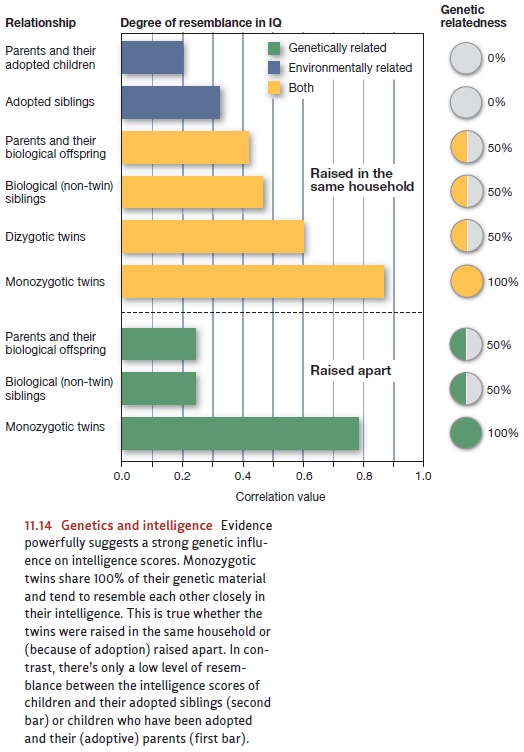Chapter: Psychology: Intelligence
The Roots of Intelligence: Genetics and Individual IQ
Genetics and Individual IQ
As
we first saw, there are several ways to evaluate how strongly a given trait
(eye color, height, career choice) is influenced by genetics. One of our main
methods, though, begins with an examination of relatives, asking in particular
whether people who resemble each other genetically also resemble each other in
terms of the target trait. For measures of intelligence, it turns out that the
correlation between the IQs of children and the IQs of their biological parents
is about !.40;
the correlation between the IQs of biological siblings is roughly the same.
These correlations indicate a relatively strong resemblance, but these
correlations, on their own, are ambiguous. On the one side, bio-logically
related family members resemble each other genetically, and this might be the
source of the resemblance in IQ scores. But on the other side, the members of a
family usually also resemble each other in their experiences: They live in
similar social and financial circumstances; they all receive similar levels of
health care and are likely to receive similar levels of education. It’s
plausible, then, that the resemblance in their IQs might be due to this shared
environment rather than their overlapping sets of genes.
Clearly,
then, we need better evidence to help us untangle the hereditary and
envi-ronmental contributions to intelligence—and some of that evidence comes
from the study of twins. As we’ve mentioned, there are two types of twins: Identical, or monozygotic(MZ), twins originate from a single
fertilized egg. Early indevelopment, that egg splits into two exact replicas
which develop into two genetically identical individuals. In contrast, fraternal, or dizygotic (DZ),twins arise from two dif-ferent eggs,
each fertilized by a different sperm cell. As a result, fraternal twins share
only 50% of their genetic material, just as ordinary (nontwin) siblings do.
Identical
twins, therefore, resemble each other genetically more than fraternal twins do;
and this fact makes it striking that identical twins resemble each other in
their IQs more than fraternal twins do. In an early summary of the data, the
correlation for iden-tical twins was .86; the correlation for fraternal twins
was strongly positive but consid-erably lower, around .60 (Bouchard &
McGue, 1981). Other, more recent data confirm this pattern (Figure 11.14). This
certainly suggests a strong genetic component in the determination of IQ , with
greater genetic similarity (in identical twins) leading to greater IQ
similarity.
The
impact of genetic factors is even clearer when we consider results obtained for
identical twins who were separated soon after birth, adopted by different
families, and reared in different households. The data show a correlation for
these twins of about .75, which is not substantially less than the .86
correlation for identical twins reared together (Bouchard, Lykken, McGue, Segal,
& Tellegen, 1990; McGue, Bouchard,

Iacono, &
Lykken, 1993; Plomin
& Spinath, 2004).
It appears, then, that
identical genotypes lead
to highly similar
IQs even when the individuals
grow up in different environments
Similar
conclusions derive from a study that drew its data from the Colorado Adoption
Project (CAP). The CAP has been tracking 245
adopted children for
roughly 20 years, testing them
periodi- cally on several
different measures (Plomin,
Fulker, Corley, &DeFries, 1997). Thus, we have
intelligence scores for the children themselves
at various ages; we
also have scores
for the children’s biological parents, who
each share 50% of their
genetic material with the
children but who are not the adults who raised the chil- dren. Third, we have
scores for the
adoptive parents—the adults who
did raise the
children and shared
(and largely created)
the environment in which the children grew up.
These
scores allow us to compute the resemblance between the children and their
biological parents, as an indicator of how much shared genes matter. The scores also allow us to compute the
resemblance between the children and their adoptive parents, as an indicator of
how much a shared environment matters. The data ndicate a much greater
resemblance in the first comparison—children and their bio- ogical parents—even
though we’re comparing
individuals who (though
biologically related) have never even met. This indicates a powerful
role for genetic factors in shap- ing intellectual ability (Figure 11.15).

What’s especially
striking about the
CAP data, though,
is that the
resemblance between children and
their biological parents
increases as
the years go by.
When thechildren are 4 years old, for
example, there’s roughly a .10 correlation between the chil-dren’s intelligence
scores and their biological parents’ scores. By the time the children are 12,
this correlation is almost .20. By the time the children are 16 years old, this
cor- relation is almost .40—despite the
fact that, by that
point, it has been
more than a dozen years since the children and their
biological parents have seen each other!
How
should we think about this result? One possibility is that what’s inherited via
the genes is a learning capacity—and so, in early childhood, a
child’s potential might resemble that of her biological
parents, but the potential hasn’t yet grown into skills we can measure. To
detect the resemblance, we must
wait until the
child has had some experience in the world—and thus
opportunity to use her learning
capacity and to gain from
the potential she
inherited. Only then, when the
potential has borne fruit, can we
detect the full
resemblance between parents
and their biological
off- spring (cf. Plomin & DeFries, 1985; Plomin & Spinath, 2004;
Figure 11.16).

Related Topics